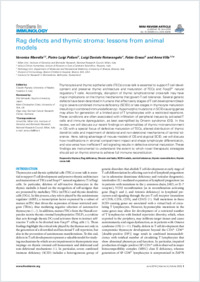Rag defects and thymic stroma : lessons from animal models
- Marrella, Veronica Milan Unit, Institute of Genetics and Biomedic Research, National Research Council, Milan, Italy - Istituto Clinico Humanitas, Istituto di Ricovero e Cura a Carattere Scientifico, Rozzano, Italy
- Poliani, Pietro Luigi Pathology Unit, Department of Molecular and Translational Medicine, University of Brescia, Brescia, Italy
- Notarangelo, Luigi Daniele Division of Immunology, Boston Children’s Hospital, Boston, MA, USA
- Grassi, Fabio Institute for Research in Biomedicine (IRB), Faculty of Biomedical Sciences, Università della Svizzera italiana, Switzerland
- Villa, Anna Milan Unit, Institute of Genetics and Biomedic Research, National Research Council, Milan, Italy - Istituto Clinico Humanitas, Istituto di Ricovero e Cura a Carattere Scientifico, Rozzano, Italy
-
02.06.2014
Published in:
- Frontiers in immunology. - 2014, vol. 5, p. 259
Thymus
Rag deficiency
Omenn and leaky SCID models
Central tolerance
Thymic reconstitution
Thymic cross-talk
English
Thymocytes and thymic epithelial cells (TECs) cross-talk is essential to support T cell development and preserve thymic architecture and maturation of TECs and Foxp3+ natural regulatory T cells. Accordingly, disruption of thymic lymphostromal cross-talk may have major implications on the thymic mechanisms that govern T cell tolerance. Several genetic defects have been described in humans that affect early stages of T cell development [leading to severe combined immune deficiency (SCID)] or late stages in thymocyte maturation (resulting in combined immunodeficiency). Hypomorphic mutations in SCID-causing genes may allow for generation of a limited pool of T lymphocytes with a restricted repertoire. These conditions are often associated with infiltration of peripheral tissues by activated T cells and immune dysregulation, as best exemplified by Omenn syndrome (OS). In this review, we will discuss our recent findings on abnormalities of thymic microenvironment in OS with a special focus of defective maturation of TECs, altered distribution of thymic dendritic cells and impairment of deletional and non-deletional mechanisms of central tolerance. Here, taking advantage of mouse models of OS and atypical SCID, we will discuss how modifications in stromal compartment impact and shape lymphocyte differentiation, and vice versa how inefficient T cell signaling results in defective stromal maturation. These findings are instrumental to understand the extent to which novel therapeutic strategies should act on thymic stroma to achieve full immune reconstitution.
- Language
-
- English
- Classification
- Biological sciences
- License
- Open access status
- gold
- Identifiers
-
- RERO DOC 326796
- DOI 10.3389/fimmu.2014.00259
- ARK ark:/12658/srd1319035
- Persistent URL
- https://n2t.net/ark:/12658/srd1319035
Statistics
Document views: 208
File downloads:
- Texte intégral: 226
